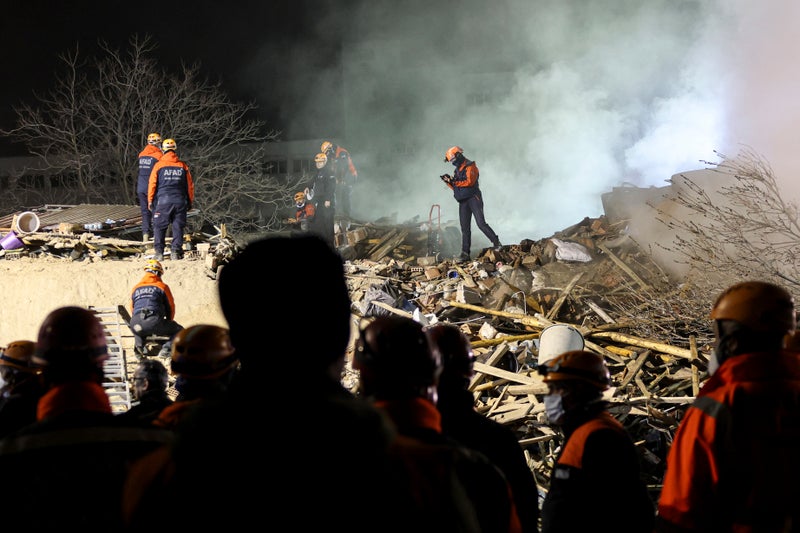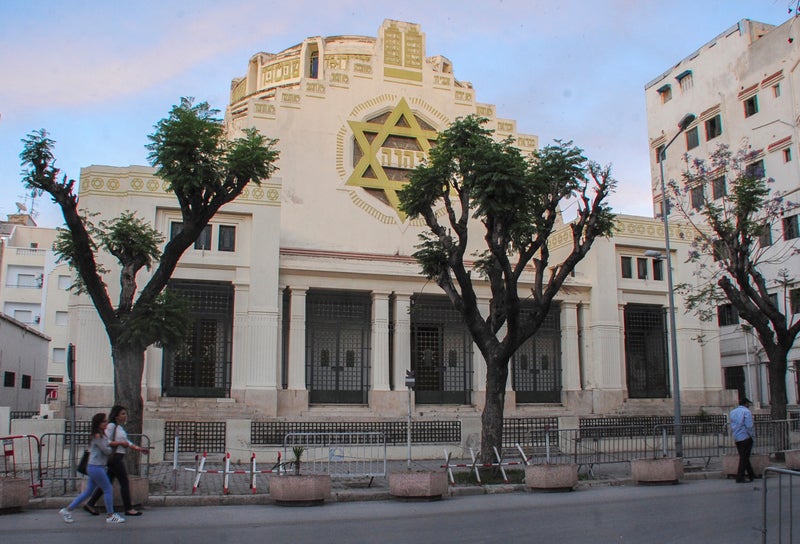Six weeks after a devastating blaze in Accra ripped through one of the world’s biggest secondhand markets, many stalls remain unfinished and thousands still have no income. It was a blaze that left two people dead and destroyed the fabric of one of the world’s largest secondhand clothes markets. It also wiped out the livelihoods of tens of thousands of people in a matter of hours.
![[Sarah Johnson]](https://i.guim.co.uk/img/uploads/2019/07/25/Sarah_Johnson.png?width=75&dpr=1&s=none&crop=none)
Six weeks on from the 1 January fire in Ghana’s capital, Accra, the aluminium roofing has been replaced and wooden frames have been erected, but many stalls remain unfinished and empty. In the heart of the market, the sound of hammering and building work fills the air. Vendors mill around with little to sell. The narrow passageways – once so rammed with customers there was a stampede two months ago – are easy to pass through.
![[An aerial view of people in the destroyed and still smoking Kantamanto market ]](https://i.guim.co.uk/img/media/c3944086ef38e7ffe0790f197b745861ea35267a/0_0_5464_3640/master/5464.jpg?width=445&dpr=1&s=none&crop=none)
Before the fire, Kantamanto was a sprawling complex of thousands of stalls crammed with clothes from brands including H&M, Levi Strauss, Tesco, Primark, New Look and more. About 30,000 people depended on it to make a living – now they are struggling.
![[People unload sacks from a lorry]](https://i.guim.co.uk/img/media/0e90f2dc9bcd1632c261ba90491341ab8dd87fcd/0_0_6720_4480/master/6720.jpg?width=445&dpr=1&s=none&crop=none)
The market is one of the biggest destinations in the world for secondhand garments – known locally as obroni wawu or “dead white person’s clothes” – from countries in the global north. “It has been tough for us since the fire. It’s really crazy, it’s very bad,” says Richard Kwaku Kwakye, 37, who is standing in front of the area where he used to sell women’s dresses. Not a piece of clothing is in sight and the floor is rubble.
![[Fishing boats on a beach where the sand is almost completely covered with waste, mainly discarded clothes.]](https://i.guim.co.uk/img/media/aac5d0f18bf36d3e3466cf011a1b21c989596ba3/0_0_4032_2268/master/4032.jpg?width=465&dpr=1&s=none&crop=none)
His stall, containing more than 100,000 Ghanaian cedis (£5,135) worth of goods, was burned to ashes in the fire, which started at about 10pm and destroyed two-thirds of the market. One person died as flames engulfed Kantamanto, and another died a few days afterwards of a heart attack. Despite rumours that it was arson, no cause has officially been identified.
![[A man in T-shirt and jeans leans against a wooden frame]](https://i.guim.co.uk/img/media/b719ed1bd5cd78d36c0dbb8ac1ac3faac1c4dce3/0_0_6720_4480/master/6720.jpg?width=445&dpr=1&s=none&crop=none)
“I couldn’t retrieve a pin from the place. Nobody could,” says Kwakye. “That was how bad it was … it took 30 to 45 minutes to trace my spot.”. In 2023, Ghana imported $121m (£96m) of used clothes, making it the world’s eighth largest importer. These garments come primarily from the UK, China and the US. The majority are sold to exporters and importers, who sell them in 55kg bales to vendors in Kantamanto.
![[Charred concrete walls with holes where wiondows and doors once were through which can be seen wooden rails hung with clothes.]](https://i.guim.co.uk/img/media/de54cbc51bb64f016f14fc3263505c32520ad496/0_182_6497_3898/master/6497.jpg?width=445&dpr=1&s=none&crop=none)
As fast fashion – clothes bought cheaply and quickly cast aside – has grown, the volume of clothing coming to the market has increased and the quality has dropped. For decades, the community at the market has washed, repaired and refashioned clothing to sell on, but according to research from Giz Ghana carried out in 2023-24, 26.5 tonnes – millions of items of clothing – now leave the market as waste every week.
![[A man in black T-shirt and cap at a workbench with clothes on a rail and hangers beside him. The Revival is printed on the wall. ]](https://i.guim.co.uk/img/media/16c068c9fb258cead45c1ef6b86230e185ab293a/0_0_6566_4377/master/6566.jpg?width=445&dpr=1&s=none&crop=none)
The waste ends up in unsanctioned dumps before some of it is washed out to sea, where currents drag it towards Accra’s beaches. The situation has attracted international attention, and featured in a Netflix documentary released late last year. Every vendor, including Kwakye, has experience of finding dozens of items in a bale that they cannot sell, because they are torn or stained. However, before the fire, he managed to make between 3,500 and 6,600 cedis a month. He has had no income so far this year, and any savings have gone on rebuilding his stall.
![[Aerial view of rows of yellow bales stacked along a roadside between buildings]](https://i.guim.co.uk/img/media/c2d84a97967faf7f4b1f2a78f301282bdbeb8516/0_0_3945_2219/master/3945.jpg?width=445&dpr=1&s=none&crop=none)
He can’t resume selling because his stall isn’t finished and he has nowhere to store goods. A stall costs between 4,000 and 8,000 cedis to build. Kwakye has a wife and child to look after, as well as a younger brother in full-time education. His rent is due next month and he doesn’t know how he is going to pay it. “Whoever is watching us, we really need support,” he says.
![[Hands holding a strip of cloth with Dior written on it, over a huge, dirty pile of clothing waste]](https://i.guim.co.uk/img/media/be5290aa5efdc74add7625eac25178b67fdd39db/0_0_6720_4480/master/6720.jpg?width=445&dpr=1&s=none&crop=none)
This sentiment is echoed by others. “The reality is that there are definitely people who have gone hungry, who are struggling to live,” says Yayra Agbofah, founder of the Revival, a community organisation based in Kantamanto market creating awareness, art and jobs. “Most of the people who work here don’t have savings because it’s a hand to mouth deal where what they get is what they spend. There are some people who have been hugely affected.”.
![[People walk past rows of clothing laid out across railway lines, with market stalls in the background]](https://i.guim.co.uk/img/media/f7d8b59951e6c36e7e82ffd0978427a2cd61522a/0_0_6497_4331/master/6497.jpg?width=465&dpr=1&s=none&crop=none)
It’s not just stallholders who are bearing the brunt of the fire’s devastation. The market is an entire ecosystem with people carrying out a variety of roles, including food vendors, cleaners and kayayei – female porters who carry bales around the maze of passageways.
Aisha Mohammed, 18, sits surrounded by heaps of clothes in a section of the market known as borla su (waste zone), the last stop for items to be rescued before they are discarded for ever. Over a soundtrack of whirring sewing machines, she explains quietly that she has worked as a kayayoo in the market on and off for three years. She first made the 14-hour journey from Tamale in northern Ghana to Accra in 2021 in search of work. “There are no jobs where I live,” she says. “I still go back for seasonal farming work but it’s not as profitable.”.































